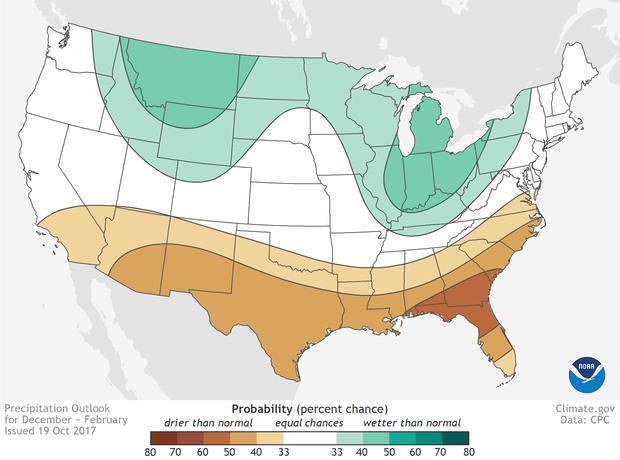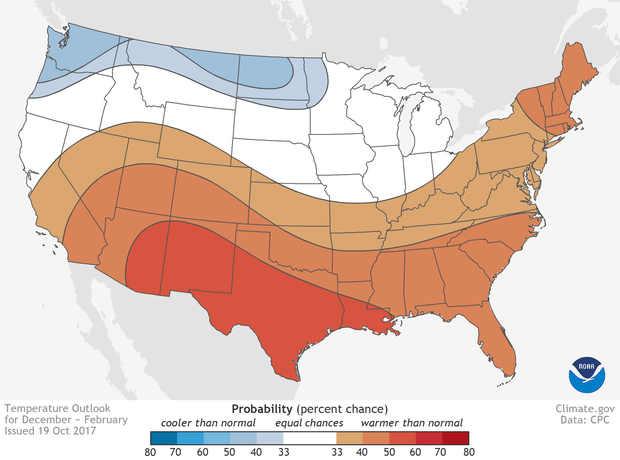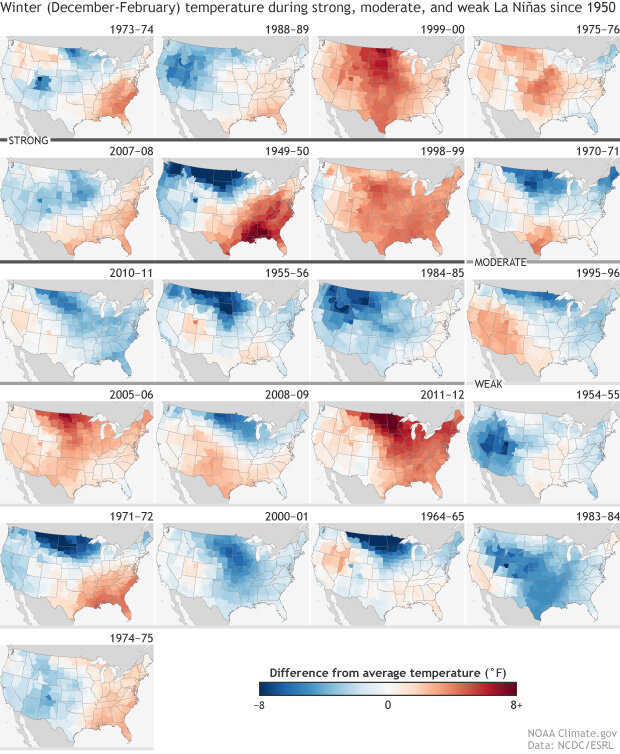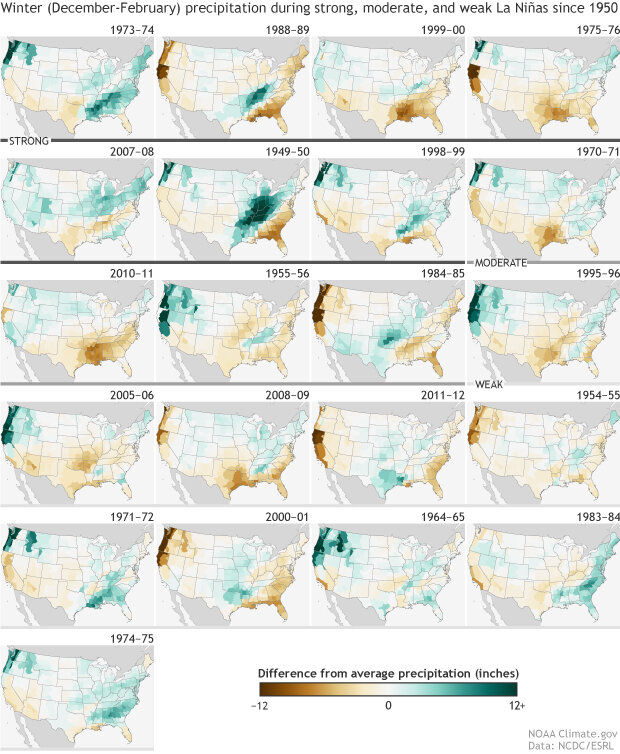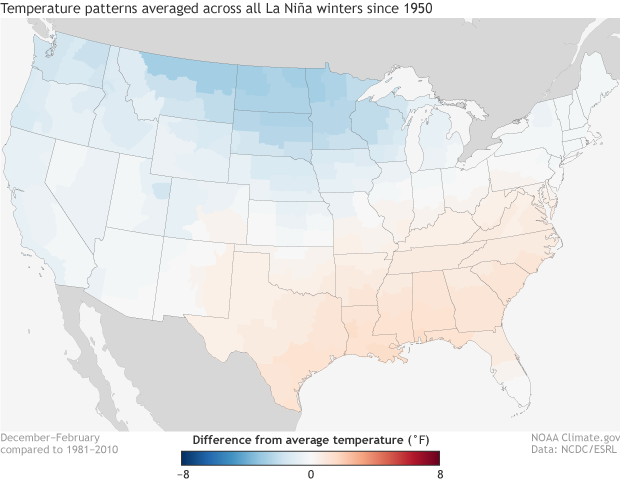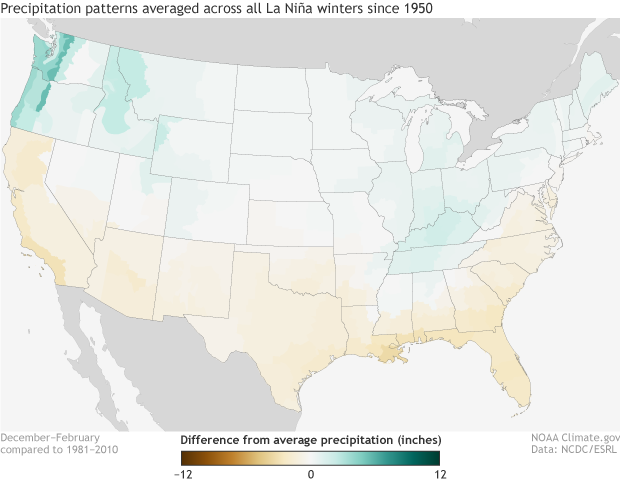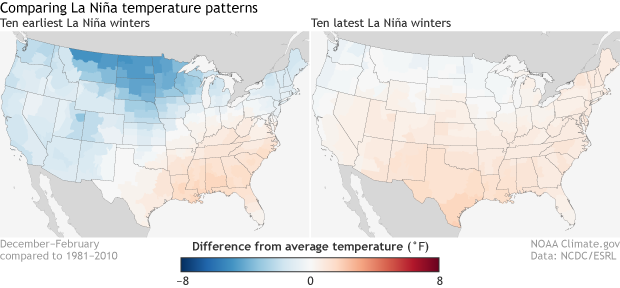Winter is coming: NOAA’s 2017-2018 Winter Outlook
Winter is coming: NOAA’s 2017-2018 Winter Outlook
If it’s October, it must be time for my annual blog post detailing NOAA’s forecast for the upcoming winter. And as always seems to be the case (well not in 2015), we’re still trying to figure out what will happen across the tropical Pacific. Here I look ahead to provide some insight as to what is most likely to occur during the upcoming winter with regards to both precipitation and temperature.
Standard reminder: probabilities are not certainties
Before discussing the outlooks, I do want to remind readers again that these forecasts are probabilities (% chance) for below, near, or above-average climate outcomes with the maps showing only the most likely outcome (1). Because the probabilities shown are less than 100% (of course), it means there is no guarantee you will see temperature or precipitation departures from normal that match the color on the map. As we’ve explained in earlier blog posts, even when one outcome is more likely than another, there is still always a chance that a less favored outcome will occur (witness precipitation during the last two winters in California).
Cut to the chase: What’s the outlook for this winter
Places where the forecast odds favor a much drier than usual winter (brown colors) or much wetter than usual winter (blue-green), or where the probability of a dry winter, a wet winter, or a near-normal winter are all equal (white). The darker the color, the stronger the chance of that outcome (not the bigger the departure from average). Click image for version that includes Alaska and Hawaii. NOAA Climate.gov map, based on data from NOAA CPC.
Both the temperature and precipitation outlooks lean on typical La Niña impacts, particularly those of the past 30 years, and bear some resemblance to the outlooks issued for last winter (not surprisingly since the forecast guidance is similar – more on that below). In the image above, the winter precipitation outlook favors below-normal precipitation across the entire southern U. S., with probabilities greatest (exceeding 50%) along the eastern Gulf Coast to the coasts of northern Florida, Georgia, and southern South Carolina. In contrast, above-average precipitation is more likely across much of the northern parts of the country, in the northern Rockies, around the Great Lakes, in Hawaii, and western Alaska.
Places where the forecast odds favor a much colder than usual winter (blue colors) or much warmer than usual winter (red), or where the probability of a cold winter, a warm winter, or a near-normal winter are all equal (white). The darker the color, the stronger the chance of that outcome (not the bigger the departure from average). Click image for version that includes Alaska and Hawaii. NOAA Climate.gov map, based on data from NOAA CPC.
The temperature outlook shown above indicates above-average temperatures across the southern US, extending northward out West through the central Rockies and all the way up to Maine in the eastern part of the nation. Above-average temperatures are also favored in Hawaii and in western and northern Alaska. Chances are greatest in an area extending from the desert Southwest to central and southern Texas and Louisiana (greater than 50%).
Probabilities are tilted toward colder-than-normal temperatures along the northern tier from the Pacific Northwest to Minnesota and also in southeastern Alaska. However, the likelihood of below-average temperatures across the North is modest, with no probabilities in these regions reaching 50%.
Both maps include blank regions where neither above-, nor near-, nor below-normal is favored. These areas (shown in white and labeled EC for “equal chances”), have the same chance for above-, near-, or below-normal (33.33%). This doesn’t mean that near-average temperature or precipitation is expected this winter in those regions, but rather that there’s no tilt in the odds toward any of the three outcomes.
The NOAA Climate Prediction Center (CPC) issues probabilistic seasonal temperature and precipitation forecasts so users can understand risk and opportunities when making climate-sensitive decisions. However, keep in mind that these outlooks will primarily benefit those who have the wherewithal to play the long game. The maps show only the most likely outcome where there is greater confidence, but this is not the only possible outcome. As we’ve seen in recent California winters, even the less likely outcome sometimes does occur.
Déjà vu all over again?
Don’t worry if the preceding paragraphs seemed familiar. You’re not crazy. Regular readers may remember that last year at this time, we were also anticipating the emergence of La Niña later in the fall. Fast forward one year and, well, the situation doesn’t look much different. If La Niña were to develop this year, certain patterns of temperature and precipitation would be favored across the United States. Over the past few years, we’ve discussed the patterns preferred by El Niño and La Niña, and recently, Tom has presented figures showing what we’ve seen historically during all La Niña winters between 1950 and now (precipitation and temperature).
December-February temperatures compared to the 1981-2010 average during each La Niña winter since records began in 1950. Gray lines under the maps indicate event strength: strong (dark gray), moderate (medium gray), and weak (light gray). NOAA Climate.gov image based on climate division data from NOAA ESRL.
December-February precipitation compared to the 1981-2010 average during each La Niña winter since records began in 1950. Gray lines under the maps indicate event strength: strong (dark gray), moderate (medium gray), and weak (light gray). NOAA Climate.gov image based on climate division data from NOAA ESRL.
From these graphics, it’s easy to see that there’s been a fair amount of variability in the winter temperature and precipitation patterns during La Niña, but also that there are some clear tendencies for above or below normal temperature or precipitation in some regions.
Another way to examine the common features of La Niña winters is to create a composite map (an average of all of these individual maps). This will highlight those regions that often have temperature or precipitation anomalies of the same sign. For temperature, there’s a strong tendency for temperatures to be below average across some of the West and North, particularly in the Northern Plains, with a weaker signal for above-average temperatures in the Southeast, as shown in the image below.
Winter temperature differences from average (1981-2010) in degrees F during La Niña winters dating back to 1950. Temperatures tend to be colder than average across the northern Plains and warmer than average across the southern tier of the United States. NOAA Climate.gov image using data from ESRL and NCEI.
Winter precipitation differences from average (1981-2010) in inches during La Niña winters dating back to 1950. Precipitation tends to be below-average across the southern tier of the United States and wetter than average across the Pacific Northwest and Ohio Valley. NOAA Climate.gov image using data from ESRL and NCEI.
The precipitation pattern, presented above, shows negative anomalies (indicating below-normal rainfall) across the entire southern part of the country with a weaker signal of above-average precipitation in the Ohio Valley and in the Pacific Northwest and the northern Rockies.
However, these figures are based on about 20 different La Niña episodes, many of them from the 1950s, 1960s, and 1970s, and we have not removed the longer-term trends from the temperature and precipitation data used here. As Tom pointed out last month, the trend is an important component of seasonal temperature forecasts. It’s fairly trivial to break the sample size in half, and compare the temperature patterns for the older half to the more recent half. That provides a significantly different picture, with the average of the latest events much warmer than the earlier ones. We can see this by comparing the right image below (more recent events) with the one to the left of it (older events).
Comparison of winter temperature differences from average (1981-2010) in degrees F between the earliest and most recent ten La Niña winters dating back to 1950. Temperatures tend to be warmer across much of the country during the most recent ten La Niña events as compared to the earliest ten La Niña events . NOAA Climate.gov image using data from ESRL and NCEI.
This picture is consistent with long term warming trends over the United States. These historical relationships along with guidance provided by a suite of computer models plays a strong role in the final outlooks. Differences between the two periods for the precipitation composites are much smaller and therefore are not shown here.
Lead editor: Nat Johnson
Footnotes
(1) The terciles, technically, are the 33.33 and 66.67 percentile positions in the distribution. In other words, they are the boundaries between the lower and middle thirds of the distribution, and between the middle and upper thirds. These two boundaries define three categories: below-normal, near-normal and above-normal. In the maps, the CPC forecasts show the probability of the favored category only when there is a favored category; otherwise, they show EC (“equal chances”). Often, the near-normal category remains at 33.33%, and the category opposite the favored one is below 33.33% by the same amount that the favored category is above 33.33%. When the probability of the favored category becomes very large, such as 70% (which is very rare), the above rule for assigning the probabilities for the two non-favored categories becomes different.
